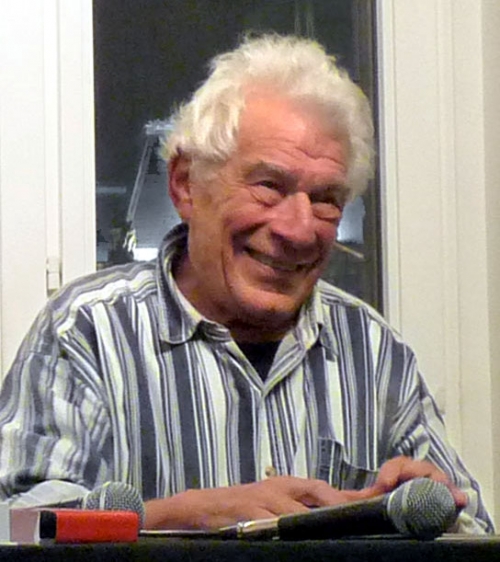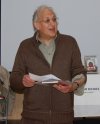What is Present: History, by John Berger

David Betteridge writes about the poem 'History'
What interests me about the existence of archives is that you enter the past which is as it were in the present tense. And so it’s another way of people who lived in the past who perhaps are still living or perhaps are dead; a way of them being present....
- JOHN BERGER
“History” is a poem which packs a lot of meaning into its eight lines:
History
by John Berger
The pulse of the dead
as interminably
constant as the silence
which pockets the thrush.
The eyes of the dead
inscribed on our palms
as we walk on this earth
which pockets the thrush.
The poem is included in a 90th birthday tribute published in Culture Matters.
Let us start with Berger’s cunningly chosen title, which points, or seems to point, to the poem’s content, or maybe to the way by which we might approach reading it. “History”, he announces. Why History, we wonder, and what aspect of History? So we read on, to find out what references there are to the Past, because History is about the Past, isn’t it?
Oddly, only Berger’s “the dead”, in both verses, seems to belong to the Past, until we consider that “the silence” is similarly devoid of life, and that “the earth” is a place where graves are dug. And, again oddly, all the verbs in the poem are in the Present tense, not the expected Past, namely “pockets” (twice) and “walk” (once). The poem seems to imply that the dead are alive, making their presence felt in the here-and-now. They are described as having a “pulse” that is “interminably constant”, and as having eyes that are “inscribed on our palms / as we walk on this earth”. (How like a painting by Dali this surreal image is!)
What of the living in this poem? Where are they? Who are they? As well as us, who walk about, looking and seeing and listening and thinking, Berger cites the thrush. He is thinking, perhaps, of the songthrush, that sings its song twice over, as is well known; or, if he is not, we, his readers, are free to conjure up that response if we wish, sharing as we do the wealth of the English language with the poet. Layers and webs and wisps of inter-textualities are all about, ready to pop into our minds as we read, bestowing an aura of extra meaning to a given text, while not contradicting it.
What presence does our thrush, full of song, have in the poem? The second half of each of the two verses tells us: first the thrush is “pocketed” by “silence”, and then it is pocketed by “this earth”, that is to say it is seized by death, or snaffled, or taken into possession, just like that. So the poem demonstrates both life-in-death and death-in-life. That is Berger’s History; or maybe it is Natural History, more like, to use an old-fashioned term. That is the constant dual reality in which we all have our being. That is the “mystery” of Berger’s little gem of a poem.
There is an alternative way of appreciating the poem, it occurs to me, looking at it again, starting not with the title and with times Past and Present, but starting with the poem’s references to Life and Death. Let us see how these twins relate, using italics and bold to distinguish them.
The pulse of the dead
as interminably
constant as the silence
which pockets the thrush.
The eyes of the dead
inscribed on our palms
as we walk on this earth
which pockets the thrush.
The poem makes these images of life and death work together – indeed walk together – very well. Line by line, we are made to see how Life and Death co-exist and interpenetrate, and do so “interminably”, being “constant” in their togethering. Significantly, the term “earth” belongs equally in both categories, as my bold italics is intended to show, earth being both the habitat of the living, and, jointly with silence, their “pocketer”.
So, as before in our first reading, we come to the same realisation of the poem’s “both-and” wisdom. Let us now explore the context – other times and places – in which Berger considered the poem’s themes. Here we can draw on the inspired scholarship of Tom Overton, Berger’s archivist; and what a voluminous archive it is that Tom has worked on, a whole vanload of boxes of decades of work driven from Berger’s house in the Haute-Savoie by Jamie Andrews of the British Library to its place of safe keeping and public access, in London.
Dear David
Thanks for writing... It looks like the section you quote comes from p16 of And Our Faces, My Heart, Brief As Photos. But as so often with JB, he’s revisiting and rephrasing an older thought in a newer context: in this case a section of a longer poem collected in Andy Croft’s edition of JB’s Collected Poems on p 43, and annotated “Jura, 1973”. JB was often hazy on remembering the dates of his writings in general, but here I think the voice and thought sounds very much of that place and period...
Happy writing — please do send me what you make of it!
V best
Tom
Straightaway, following Tom’s advice, I went to Berger’s marvellously mixed reflection on Time and Space, and Death and Life, and, cross-cutting all, the power of Poetry, namely And Our Faces, My Heart, Brief As Photos, published by Writers and Readers in 1984. I say “mixed”, because, like many of Berger’s books, it is a many-genred work, shifting rapidly and repeatedly between prose and poem, essay and memoir, fact and fiction, narrative and description.
Here is what I found on p 16: a passage in prose, prefacing the poem that we have been gnawing like a bone. In it, Berger notes the death of one of his friends, and then comments on it, and on all deaths. Key to that passage is the following thought:
Tony is no longer within the nexus of time as lived by those who, until recently, were his contemporaries. He is on the circumference of that nexus.... Yet he is also within that nexus as are all the dead...
I have to confess that I find the passage hard to understand. It appears to be self-contradictory; but then comes the poem, and in its eight lovely lines the contradiction is resolved, clearly and elegantly. A remark of David Constantine’s is proved correct, that:
Berger’s whole oeuvre – poetry, fiction, political and literary essays – is of a piece. Some poems... appear there not as lyrical interludes but as further condensations of accounts, events, characters, in the prose...
- Preface to The Long White Thread of Words: Poems for John Berger, Smokestack Books, 2016)
Chasing up Tom’s second reference, I turned to p 43 of Berger’s Collected Poems (Smokestack Books, 2014), and had a look at the poem printed there, also called “History”. Here, through the poet’s eyes, we gaze on a blue sky (not, as before, on the earth), and on buzzards (not on a thrush); but we have the same collapsing of Past and Present into a sort of Present Habitual, “regular as the sun / millennia powdered into blue /sky of all moments lived...” and we have the same sense of the presence of Death, co-habiting with Life: “the intent head / the yellow beak / the gut demanding food / talons that grip...”
These two poems by Berger both called “History” show him in a characteristic role, that of Death’s Secretary, to borrow one of his self-descriptions. “You see,” he said to an interviewer not long before his own death:
I think that the dead are with us…they are a presence. What you think you’re looking at on that long road
to the past is actually beside you where you stand...
- The New Statesman, June, 2015
Reading around, as we have been doing, looking for leads in and out of other texts, and seeking confirmations from other contexts, is akin, is it not, to Berger’s own practice as a writer, and his own practice as an artist and art-critic, too? Consider this observation from his Ways of Seeing (Penguin Books, 1972):
We are never just looking at one thing, we are always looking at the relationship between things and ourselves. Our vision is continually active, continually moving, continually holding things in a circle around itself, constituting what is present to us as we are.
Having done all this looking – looking at, and behind, and beyond, and between the eight lines of Berger’s “History” – how do we regard the poem when we return to it, as we are bound to be drawn to do, there being so much meat on its bone? There is still a “mystery” here, but one in which we can feel entirely at home.
History
by John Berger
The pulse of the dead
as interminably
constant as the silence
which pockets the thrush.
The eyes of the dead
inscribed on our palms
as we walk on this earth
which pockets the thrush.

David Betteridge
David Betteridge is the author of a collection of poems celebrating Glasgow and its radical traditions, 'Granny Albyn's Complaint', published by Smokestack Books in 2008. He is also the editor of a compilation of poems, songs, prose memoirs, photographs and cartoons celebrating the 1971-2 UCS work-in on Clydeside. This book, called 'A Rose Loupt Oot', was published by Smokestack Books in 2011.